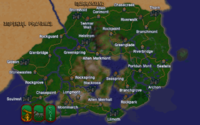| Rockgrove | |
|---|---|
| Type | Settlement |
| Continent | Tamriel |
| Province | Black Marsh |
| Region | Blackwood (Gloomire) |
| Appears in | Arena, ESO |
Rockgrove (colloquially known as Krona-Konu) is a settlement located in the Gloomire region of southwest Black Marsh, deep in Blackwood; it lies southeast of Gideon and northeast of Soulrest.[1][2]
It is a ruined city that is well known for its pre-Duskfall stonework. The Ca-Uxith tribe of Argonians live in a nearby village and have been charged by their Hist to watch over the ancient xanmeer. The xanmeer of Rockgrove lies on top of an underground series of steam vents that explode into geysers. The stone-talkers of the tribe preserve the ruins and prevent their destruction in the event of the geysers becoming active.[3][4]
HistoryEdit
Circa 2E 582, the chaos-worshipping Sul-Xan tribe raided Rockgrove under the command of Flame-Herald Bahsei, a cultist of Mehrunes Dagon. Bahsei opened an Oblivion Gate at the pinnacle of the xanmeer and used her necromantic abilities to harvest the souls of all who had died in the attack, to be sacrificed to a powerful Daedric Harvester named Xalvakka. The surviving Ca-Uxith sought aid from neighboring allies, and were able to take back the old city from the Sul-Xan invaders with the help of a group of Undaunted. This group then entered the Oblivion Gate to confront Xalvakka and destroy the sigil stone that maintained the portal. With Xalvakka's banishment, the lost Argonian souls were able to return to their Hist and the cycle of rebirth.[5] As of that time Rockgrove was famous for its pungent swamp salts, which were used as an ingredient for luxurious bathing products.[6]
During the Imperial Simulacrum in the late Third Era, Rockgrove was an active settlement. It was ruled by Count Diocletate and had a rivalry with Moonmarch.[7] Rockgrove is neighbored by several settlements, including Chasepoint to the south-southwest, Stonewastes to the northwest, and Moonmarch far to the southeast.[1]
GalleryEdit
See AlsoEdit
- For game-specific information, see the Arena and Elder Scrolls Online articles.

